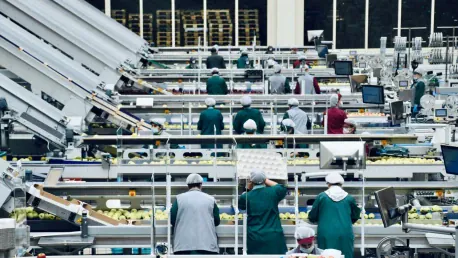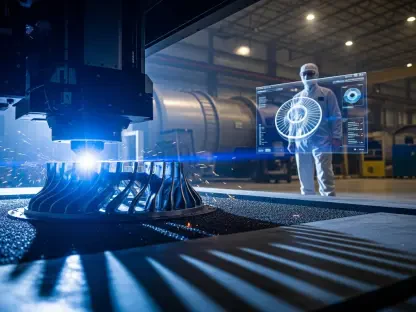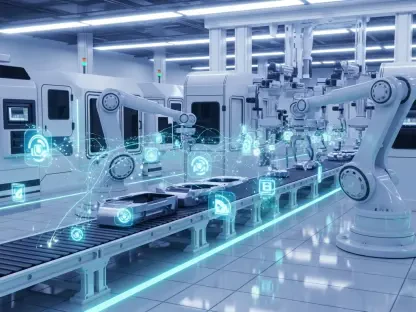The manufacturing industry is at a crossroads, facing significant challenges rooted both in workforce dynamics and technological adoption. Insights from the 2024 Manufacturer’s Technology Adoption & Attitudes Survey by ABI Research shed light on these pressing issues. Surveying 461 decision-makers in the manufacturing sector across the U.S., Malaysia, and Germany, the findings highlight the critical areas requiring attention for future growth and development.
Workforce Challenges
Recruiting and Retaining Talent
One of the primary challenges identified in the survey is workforce-related issues, with half of the top ten concerns focused on people rather than technology. Manufacturers are grappling with recruiting new talent and retaining existing staff in a competitive job market. Michael Larner, a distinguished analyst at ABI Research, observes that these human resource challenges underscore a significant need for skilled workers. Companies are not only struggling to fill positions but also battling to keep their current workforce from seeking opportunities elsewhere. The talent shortage in manufacturing is exacerbated by the increasing need for specialized skills that few workers possess.
Furthermore, the competition for skilled labor is intense, and manufacturers must offer attractive incentives to lure and retain top talent. This situation is causing a ripple effect across the industry, leading to increased salaries and better benefits packages, which in turn impact a company’s bottom line. The sector is also seeing an aging workforce that is near retirement, further intensifying the need for effective recruitment strategies. As older employees retire, they take with them a wealth of experience and expertise that is hard to replace, making the challenge of workforce retention even more acute.
Upskilling Employees
In addition to attracting and retaining employees, upskilling the current workforce is a substantial hurdle. Manufacturers need staff capable of operating and maintaining advanced equipment and optimizing production lines efficiently. This need for continuous learning and development is critical to keeping pace with technological advancements and ensuring operational efficiency. As manufacturing processes become more automated and reliant on sophisticated machinery, the demand for highly skilled workers who can manage these systems grows. This means that ongoing training and professional development programs are essential components of any successful manufacturing strategy.
The importance of upskilling is not lost on industry leaders, who recognize that investing in their workforce leads to higher productivity and job satisfaction. However, implementing effective training programs can be costly and time-consuming, posing another layer of challenge for companies already stretched thin. Despite these obstacles, manufacturers that prioritize employee development stand to benefit from a more agile and capable workforce. This not only boosts operational efficiency but also fosters a culture of continuous improvement and innovation within the organization.
Technological Adoption Trends
Cloud Collaboration
The survey reveals that 76% of respondents believe the cloud enhances real-time collaboration, significantly improving supply chain coordination. This trend is particularly noteworthy, as effective communication and coordination are vital for manufacturers to remain competitive. Cloud-based solutions offer the flexibility and accessibility needed to facilitate seamless interactions among different departments and even across global supply chains. However, the benefits of cloud scalability are less appreciated by U.S. manufacturers compared to those in Germany and Malaysia, reflecting a cautious approach to fully embracing this technology.
Despite this hesitation, the potential advantages of cloud adoption are clear. Enhanced real-time collaboration can lead to more efficient production schedules, reduced inventory costs, and faster response times to market demands. By leveraging cloud technology, manufacturers can achieve greater visibility into their operations and make data-driven decisions more effectively. This is particularly important in a world where supply chain disruptions are becoming increasingly common, underscoring the need for agile and responsive manufacturing systems.
Private Cellular Networks
Private cellular networks are recognized for their reliability and security, with 74% of manufacturers agreeing on their importance in streamlining operations. These networks provide a stable and secure connection, reducing downtime and enhancing overall productivity. The adoption of private cellular networks reflects a growing awareness of the need for robust and reliable communication infrastructure in the manufacturing sector. These networks offer a dedicated bandwidth that ensures consistent performance, which is crucial for maintaining uninterrupted production processes.
Additionally, the security benefits of private cellular networks cannot be overstated. With the increasing prevalence of cyber threats, manufacturers must prioritize secure communication channels to protect sensitive information and maintain operational integrity. Private networks offer enhanced security features that help safeguard against potential breaches and unauthorized access. This makes them an attractive option for manufacturers looking to bolster their cybersecurity posture while also reaping the operational benefits of a reliable communication system.
Cybersecurity Concerns
Regional Priorities in Cybersecurity
Cybersecurity remains a critical concern, with differing priorities across regions. For manufacturers in the U.S. and Malaysia, vulnerabilities associated with new technologies are the top cybersecurity risk. In contrast, German manufacturers are primarily worried about data breaches. This divergence highlights how geographical context influences cybersecurity strategies and the specific threats that manufacturers prioritize. Understanding these regional differences is essential for developing effective and targeted cybersecurity measures that address the unique challenges faced by manufacturers in different parts of the world.
In the U.S. and Malaysia, the rapid adoption of new technologies has introduced new vulnerabilities that cybercriminals are quick to exploit. This has made it imperative for manufacturers to invest in advanced security solutions that can detect and mitigate these risks. On the other hand, German manufacturers, who are more concerned about data breaches, focus on safeguarding personal and sensitive information from being compromised. Each region must tailor its cybersecurity strategies to address the most pressing threats effectively.
Addressing Vulnerabilities
Given the increasing reliance on digital technologies, addressing cybersecurity vulnerabilities is paramount. Manufacturers must implement comprehensive security measures to protect sensitive data and ensure the integrity of their operations. This includes regular updates, employee training, and adopting advanced security protocols to mitigate risks. A multi-layered security approach that combines technical solutions with best practices is essential for creating a resilient cybersecurity posture. Regularly updating software and systems to patch known vulnerabilities is a critical first step.
Employee training programs are equally important, as human error remains one of the most significant cybersecurity risks. By educating employees on recognizing and responding to potential threats, manufacturers can significantly reduce the likelihood of successful cyberattacks. Additionally, adopting advanced security protocols such as encryption, two-factor authentication, and continuous monitoring can help detect and prevent unauthorized access. These measures collectively contribute to a robust cybersecurity framework that protects against a wide range of threats.
Embracing Advanced Technologies
Generative AI for Efficiency
A striking 78% of survey respondents believe that generative AI can swiftly identify production issues, thereby enhancing operational efficiency. Generative AI offers manufacturers a powerful tool for predictive maintenance, quality control, and process optimization, enabling them to proactively address potential problems and improve overall productivity. The ability of AI to analyze vast amounts of data in real time allows for early detection of anomalies and swift corrective action, reducing downtime and production delays. This proactive approach is a game-changer in the manufacturing sector, where even minor disruptions can have significant financial implications.
Furthermore, generative AI can assist in designing more efficient production processes, identifying areas for improvement that may not be apparent to human operators. By leveraging AI-driven insights, manufacturers can optimize their operations and make more informed decisions that enhance productivity and reduce costs. This not only improves operational efficiency but also provides a competitive edge in an increasingly fast-paced and technology-driven industry. The adoption of generative AI reflects a broader trend towards embracing advanced technologies to solve complex manufacturing challenges.
Industrial Metaverse Potential
The industrial metaverse is gaining traction, with 79% recognizing its potential in supporting new product development. This emerging technology provides a virtual space for manufacturers to design, test, and refine products without the constraints of physical limitations. German and Malaysian manufacturers focus on leveraging the metaverse for product design, while U.S. firms see it as a useful tool primarily for staff training. The versatility of the industrial metaverse allows manufacturers to explore innovative solutions and accelerate the development cycle, bringing products to market faster and with greater precision.
The industrial metaverse also offers unique opportunities for collaboration and knowledge sharing across global teams. Engineers and designers can work together in a virtual environment, testing different scenarios and making adjustments in real time. This collaborative approach not only speeds up the development process but also fosters innovation by allowing diverse perspectives to be integrated into the product design. The ability to simulate and test products without physical prototypes reduces costs and minimizes risks, making the industrial metaverse a valuable tool for modern manufacturers.
IT and OT Collaboration
Integration Challenges
Despite the importance of integrating IT and operational technology (OT) teams, only 39% of respondents report effective collaboration. The disconnect between IT and OT often leads to inefficiencies and hampers the seamless adoption of advanced technologies. Addressing this gap is essential for manufacturers to harness the full potential of their technology investments. Without effective collaboration, the implementation of new technologies can be fragmented and less effective, limiting the overall benefits for the organization.
One of the main challenges in integrating IT and OT teams is the difference in culture and priorities. While IT focuses on data, security, and network management, OT is concerned with the operational aspects of manufacturing processes. Bridging this cultural divide requires a concerted effort to align goals and foster a collaborative mindset. By creating a unified approach, manufacturers can ensure that IT and OT teams work together seamlessly to implement and optimize new technologies.
Steps Toward Better Collaboration
Improving collaboration between IT and OT teams requires a strategic approach, including cross-functional training, aligning goals, and fostering a collaborative culture. By bridging this gap, manufacturers can enhance their ability to innovate and respond to emerging challenges more effectively. Cross-functional training programs can help build mutual understanding and respect between IT and OT teams, enabling them to work together more effectively on shared projects. Aligning goals involves setting common objectives that encompass both IT and OT priorities, ensuring that both teams are working towards the same end.
Fostering a collaborative culture requires strong leadership and clear communication. Leaders must champion collaboration and provide the necessary resources and support to facilitate it. Regular meetings and open lines of communication can help maintain alignment and address any issues that arise. By prioritizing collaboration, manufacturers can create a more cohesive and agile organization capable of adapting to the rapidly changing technological landscape. This not only enhances operational efficiency but also positions manufacturers to capitalize on new opportunities and stay competitive in the market.
Sustainability Initiatives
Current State of Sustainability
Sustainability remains a relatively low priority, with only 23% of manufacturers emphasizing this goal. Despite the growing recognition of environmental responsibility, many manufacturers have yet to integrate sustainable practices into their core operations. This lag presents an opportunity for growth and innovation in an increasingly eco-conscious market. Manufacturers that adopt sustainable practices can not only reduce their environmental footprint but also gain a competitive advantage by appealing to environmentally conscious consumers and meeting regulatory requirements.
The current state of sustainability in manufacturing indicates a gap between awareness and action. While many manufacturers recognize the importance of sustainability, the implementation of eco-friendly practices often takes a back seat to more immediate operational concerns. Overcoming this inertia requires a commitment to sustainability at every level of the organization, from top leadership to individual employees. By making sustainability a core value, manufacturers can drive meaningful change and position themselves as leaders in the industry.
Potential for Growth
The manufacturing industry stands at a critical juncture, grappling with substantial challenges in both workforce dynamics and the pace of technological adoption. The 2024 Manufacturer’s Technology Adoption & Attitudes Survey conducted by ABI Research offers valuable insights into these issues. This comprehensive survey, involving 461 decision-makers from the manufacturing sector in the U.S., Malaysia, and Germany, illuminates the pivotal areas that need urgent attention to drive future growth and development.
Amid rapid technological advancements, the industry faces a pressing need to integrate new technologies seamlessly into existing systems. However, this is often hampered by a skills gap in the workforce, where employees may lack the necessary training or expertise to operate advanced machinery or software. Additionally, reluctance to change and invest in cutting-edge technology can stagnate innovation and efficiency.
The survey’s findings emphasize that overcoming these hurdles is crucial for the manufacturing sector’s evolution. Strategies such as enhanced training programs, stronger emphasis on STEM education, and fostering a culture of continuous improvement and adaptability are essential. By addressing these critical areas, the industry can navigate its path forward, ensuring sustainable growth and competitive advantage in the global market.









